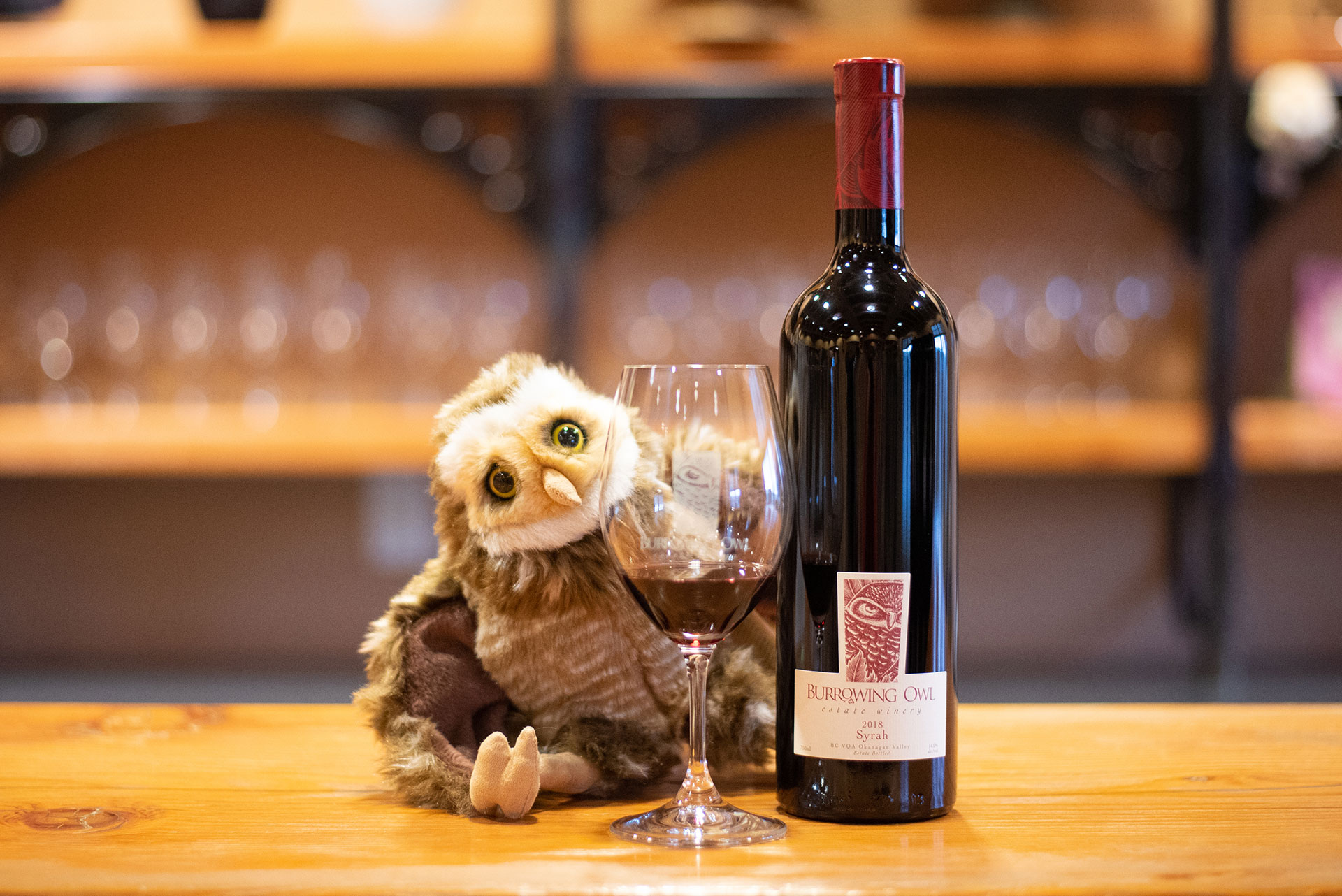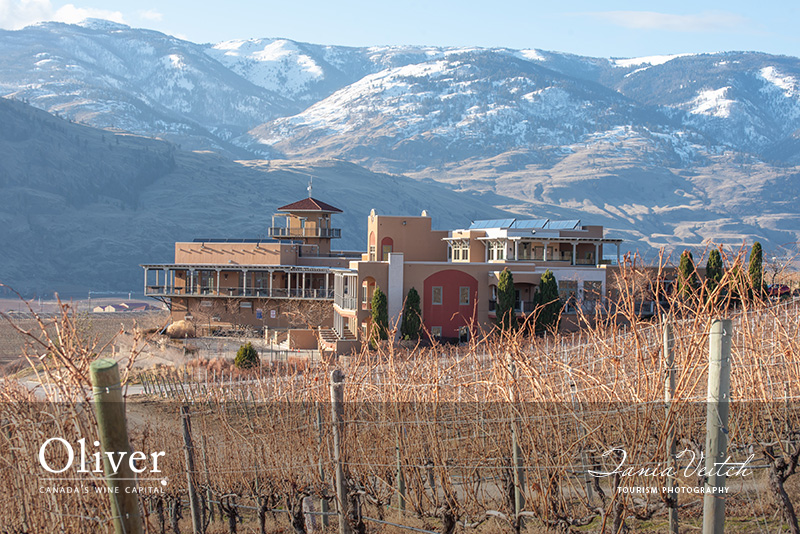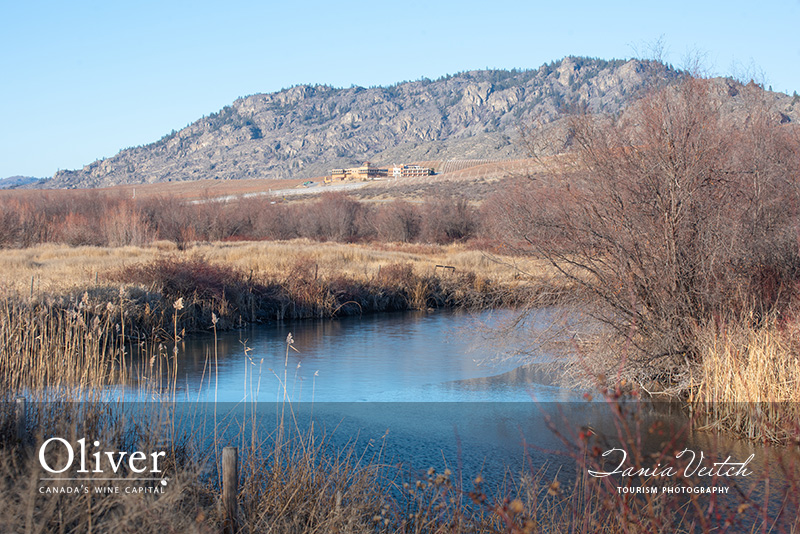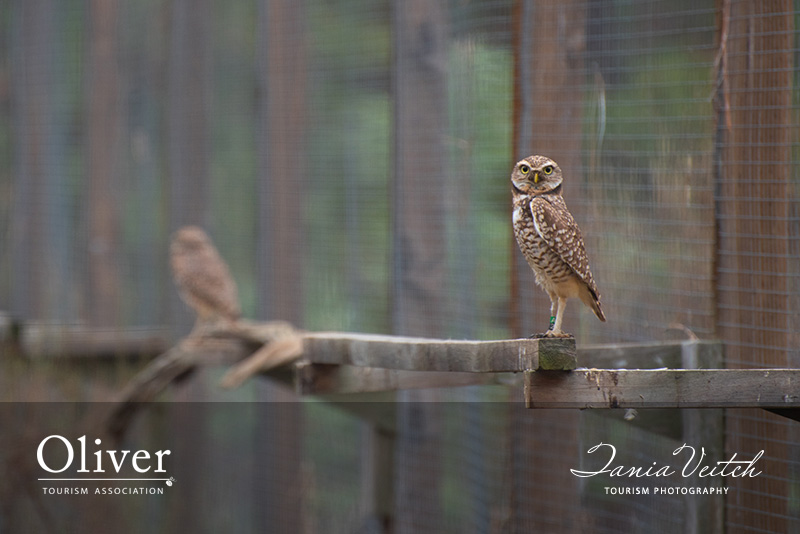
Drink Wine & Feed Owls
There’s a lot to love about Burrowing Owl Estate Winery aside from the fact that they make delicious wine and sit in a beautiful location on the sun-kissed Black Sage Bench surrounded by luscious vineyards. They are also big on philanthropy and environmental sustainability.
What’s even better is that you can help support the cause simply by visiting and sipping their wine.
Victoria, a Burrowing Owl Wine Ambassador, explained to me, “We offer five samples of wine for $5 and that $5 goes directly to the Burrowing Owl Conservation Society of BC.”
I was surprised by their low tasting fees which include five varietals believe it or not. That’s just $1 per sampling of delicious wine! If you want to give more you can.
Burrowing Owl Estate Winery goes even further as to donate $25 of the sold-off used wine barrels to the cause.
When I dug further and asked what Victoria likes most about working at Burrowing Owl Estate Winery she listed four reasons.
Firstly, the delicious wines. They’re not hard to represent, she says.
Secondly, the people she works with. Everyone likes each other.
Thirdly, the owners are philanthropic. They give to the Burrowing Owl Conservation Society of BC.
Fourthly she explained, “I love all the green initiatives around the property. We’ve got solar panels on the roof of the restaurant for heating our hot water. They (the winery) installed a canopy in the parking lot that has electrical panels. There are charging stations: two (spots) for Tesla and two for e-cars. The 16-bedroom migrant house is powered with solar panels.”
Victoria continued, “Yes, they’re taking from the land but they’re also giving something back to the environment.”
It’s certainly more than most business landowners in Canada do.
So on your next visit to Oliver for wine tasting, you can literally help increase the population of endangered Burrowing Owls if you add Burrowing Owl Estate Winery to your list of places to sip at.
A Visit To The Burrowing Owl Conservation Society of BC
After visiting the winery, I immediately contacted and visited the Burrowing Owl Conservation Society of BC (BOCSBC) to learn first hand what they do and in what way your wine tasting dollars are being spent. It’s pretty cool!
Plus, you may be surprised just why Burrowing Owls are endangered. It might not be what you think!
I had the wonderful opportunity to speak with Lauren Meads, Executive Director of BOCSBC, and ask her questions. Here’s what she had to say.
What does the Burrowing Owl Conservation Society of BC (BOCSBC) do?
We’re a reintroduction program. We breed wild Burrowing Owls in captivity. They are endangered in Canada and have been gone from BC since the 1980s.
We put a male and a female in each pen and then they will have young. Those young will grow up. All of the owls in here (right now) are the parents and the ones that were born last year. The ones that were born last year will be released in April to burrows that we provide for them out in grasslands mostly on private ranches and some provincial and federal conservancy sites.
Why are the Burrowing Owls endangered?
There are many causes for the decline of Burrowing Owls. One reason is due to the loss of burrowing mammals. We would (normally) have had a lot of badgers here in the South Okanagan but they are also endangered. Other reasons for their decline are climate change, loss of their prey (pesticides), increased predatory animals (mainly hawks and other owls), roadways, and decreases in the availability of grasslands.
How does the loss of burrowing mammals affect Burrowing Owls?
They (burrowing mammals) would have dug burrows, abandoned them, and then these guys (the owls) would go in them. Burrowing Owls don’t dig their own burrows. They prefer to take over other existing burrows and re-model them.
There is a subspecies of Burrowing Owls in Florida and other sandier areas where they can dig their own burrows but they’re shallower. Here, we have rockier soil.
How do they cope with the winter here?
They can survive here in the winter if there is food, and access to a burrow. In the wild, food, rodents, and insects that they would normally eat, are harder to find. Also, their burrows get plugged with snow. They’re more likely to survive if they migrate.
Where do Burrowing Owls usually migrate?
Our owls migrate down the coast to California and Mexico. There are owls that don’t migrate (for example) ones in southern California, Arizona, and Mexico. They stay all year. Anything in the northern United States and Canada migrates.
What do you do here to ensure that the owls survive after they are released?
We feed them dead mice and dead day-old chicks which are an off-shoot of the poultry industry.
When we put them out into the wild, we use bigger burrows. They are plastic and deeper so the temperature is controlled better. We also provide supplement feed.
How many release facilities do you have?
We have three locations: Oliver, Kamloops Wildlife Park, and Langley.
Between the three facilities, we produce approximately 100 birds per year and then we release them. We try to release them in pairs (males/females).
How do you reintroduce them to the wild?
We install a cage around the (wild) burrow for the first couple of weeks so that they stay. We call it a soft release.
We take them from the controlled environment and put them out into the wild but still protect them for a bit. We feed them and get them used to the burrow then we take the cage off and hope that they will mate and have young of their own.
Those young are true wild-born Burrowing Owls. Those are the ones we hope will migrate and then come back.
How many come back each year?
Migration is hard for any species. It’s full of dangers. They do it because the benefits outweigh the negative.
Unfortunately, it’s still quite difficult for Burrowing Owls. We don’t have a huge amount coming back. They are either dying on the way down or dying on the way back.
A few years ago, we had good returns. The last couple of years have gone down again. That’s probably related to expanding agriculture and climate change. If it’s really wet in the winter in Mexico and California, it impacts them here. Here, it’s also getting wetter during May and June which is when they have their young.
How does the wet affect them?
The rain floods their burrows, they get damped out, they’re also not able to hunt as readily, insects aren’t there.
Up here (Oliver) it gets colder. Even though we are giving them extra food, we don’t know why they’re not surviving. They can overcome a little bit of rain and difficult climate but if it’s one thing after another after another, it’s challenging. Here, they get rain, cold, and fires.
How did Burrowing Owl Estate Winery and the Conservation Society get connected?
The government tried to do a reintroduction program across the street from where Burrowing Owl Estate Winery is now. That’s why it was named Burrowing Owl Estate Winery. Jim and Midge (owners) had seen an old sign and named it that.
A couple of years later they were growing grapes and saw an article about our president Mike Mackintosh who lives on the coast. He said he was going to start a breeding program for Burrowing Owls so Jim contacted him.
The winery has been involved with the Society since day one in the early ’90s. They started with one breeding facility and a few landowners mostly up in the Nicola Valley between Merritt and Kamloops.
In the early 2000s, the Burrowing Owl Conservation Society of BC (BOCSBC) became an official non-profit society, so we could accept donations.
Since 2010, we expanded down into the South Okanagan and this facility was built.
How do you raise funds to support BOCSBC?
Normally, we have a booth at SORCO’s (South Okanagan Rehabilitation Centre for Owls) open house. Last year they didn’t have it because of COVID.
People can also donate online via the website. We have Paypal and Canada Helps that people can donate through. People can donate a legacy as well. We’ve had a few of those. People can also mail us cheques.
People can also go to Burrowing Owl Estate Winery and just drink wine. They can give more than the $5 (tasting fee) donation if they want.
How often do you visit the winery?
I usually go to the winery five times per year to show people that their donations actually do fund this conservation society.
They fund the non-sexy parts.
We can get a lot of grant money for the fieldwork. But for buying mice and chicks to feed these guys, that’s a hard sell. People tasting wine think it’s kind of fun. You taste the wine and it buys food for the owls.
Each owl needs two mice per day. It costs $1 per mouse. Each of our facilities has 40 – 50 owls so you can calculate that. Food is one of our biggest expenses. $5 equals five mice.
If it wasn’t for COVID, I would have done some tours and things like that. We would have been part of the Meadowlark Festival and the Desert Centre. We would have done school presentations too, but right now everything is on pause.
Drink Wine & Feed Owls
So next time you plan to visit Oliver BC, get in touch with Burrowing Owl Estate Winery to book your wine tasting experience and at the same time help feed these cute little owls that are struggling to make a come-back in BC.
Although the Burrowing Owl Conservation Society of BC is not physically open for public viewing, you can see what they’re up to on their website and Facebook page.
If you’re interested in donating to BOCSBC online, here’s how you can do it!











